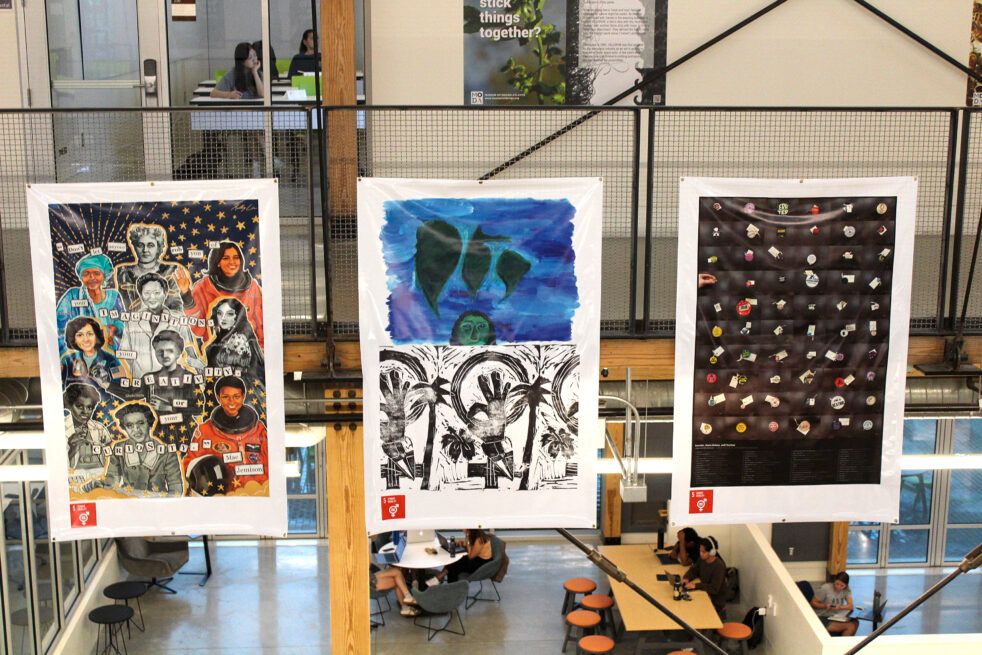Upon entering Tech’s Kendeda Building for Innovative Sustainable Design, eyes are instantly drawn to the splashes of color that contrast with the establishment’s normally neutral tones.
These vibrant colors can be seen on large banners of artwork that hang from the second-floor railings.
When moving to the right side of the room to get a better look, there are multiple stands with different forms of media sitting atop them, ranging from poems to collages.
A red square with a symbol for gender equality and the number five can be seen at the bottom of each piece of art.
Returning to the entrance of the building, a large sign with the same marking reads “Gender Equality: Reimagining our Future through Art and Technology.”
It explains that the various media in the building was submitted by women and non-binary people associated with Tech.
The artists consist of undergraduate and graduate students, faculty, researchers and staff.
Additionally, there is a QR code in the bottom right-hand corner of the poster that takes viewers to a digital magazine where each piece is explained and each artist is introduced.
After walking through the building and examining the art, it is evident that each form of art is meaningfully placed; no matter where someone stands, they can admire the work.
The text media, such as Shruthi Sundar’s “My Hair Was Never Meant to Be Beautiful” and Alexandra Rodriguez Dalmau’s “Nuestra Hermandad: primeras nueve mujeres latinas en Tech,” sits on stands where people can go up close and read each piece.
The large banners of art hanging from the railings above, such as Anne Sullivan’s “Gender Representation in the Post-Anthropocene World” and Kelly Lin’s “The Named Pioneers,” can be viewed from almost anywhere in the open room.
Michelle Ramirez, the curator of the exhibit, was required to conduct a Master’s project or thesis for the Institute’s Digital Media Master’s program which she completed in May.
When brainstorming ideas, Ramirez took inspiration from her Social Design and Social Justice lab and decided to base the project around aspects of the class, such as the discussion of ethical issues and storytelling.
Jason Gregory, a senior facilities planner at Tech, was the one who suggested to Ramirez that she should execute a digital piece that inspires women, since 2022 is the 70th anniversary of women being allowed to study at the Institute. Bouncing off of this idea, she landed on the questions that would act as the foundation for her project: “Why are we only celebrating 70 years of women? What stories are we celebrating?” At the same time, Ramirez was a graduate research assistant with Serve Learn Sustain (SLS), an organization at Tech that works to bring sustainability competencies to campus.
Her advisor, Rebecca Watts Hull, proposed that she should incorporate her project with Sustainable Development Goal 5, Gender Equality.
Ramirez did this by creating an exhibition that includes different forms of art by cisgender women, transgender women and nonbinary people on Tech’s campus.
She then narrowed the main idea of this exhibition down to a discussion of women in science and how they are making a difference.
“The biggest goal was to get more female and nonbinary student voices in a centralized place on campus,” Ramirez said when asked about her hopes for the exhibit.
She references the impact that Banu Subramaniam’s “Ghost Stories for Darwin,” a book on the relationship between biology and feminist inquiries, had on the exhibit since it brought her to a fundamental question: “How are women in science redefining what science means?”
The exhibit has been showing since April of 2022 and will continue until Dec. 9. When visiting the display, the Technique asked various visitors in the Kendeda Building about how the artwork made them feel.
A pattern seemed to emerge among the new freshmen on campus. Many said that they felt comforted by the artwork created by women who were making a difference at Tech.
Rebecca Fishman, first-year LMC student, said that the exhibit “makes Tech feel like a place where everyone has the opportunity to stand out no matter their identity.”
Furthermore, the Technique asked contributors to describe the impact that participating in the exhibit had on them.
Alexandra Riggs, a Ph.D. student in Digital Media at Tech, submitted the work “Lorraine, Maria Helena, and Charlene,” an artifact portrait that represents the three activists responsible for the patchwork of Atlanta’s LGBTQ+ organizations.
Riggs expressed appreciation towards Ramirez for creating an exhibit that “centers the experiences of BIPOC women and nonbinary folks, specifically in relationship to sustainability and environmental justice.”
The Sustainable Design Goal (SDG) 5, Gender Equality exhibit can act as a safe place on Tech’s large campus, where it can sometimes be easy to feel lost in a sea of people.
